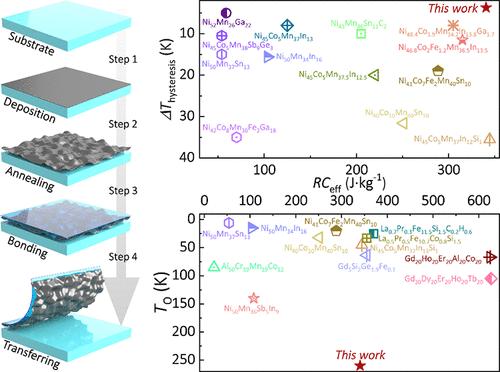Quasi-Second-Order Martensitic Phase Transition by Flexomagnetic Coupling
IF 9.1
1区 材料科学
Q1 CHEMISTRY, MULTIDISCIPLINARY
引用次数: 0
Abstract
Heusler alloys, known for their first-order martensitic transformation, have found widespread applications in various technological fields. However, the intrinsic hysteresis associated with the phase transitions, combined with the narrow operating temperature range, limits their performance in smart metallic components and energy-efficient devices. Here, we introduce inhomogeneous strain gradients into the wrinkled Ni–Mn–Sn Heusler alloy thin film, facilitating a quasi-second-order martensitic transformation with dramatically reduced hysteresis (ΔThysteresis = 3.7 K). This flexomagnetic coupling not only enhances the ferromagnetic interaction but also broadens the operating temperature window (To = 260 K) for magnetic entropy change, offering substantial improvements in saturation magnetization (Ms = 71.3 emu/g) and effective refrigeration capacity (RCeff = 340.6 J·kg–1 under 50 kOe). Our findings offer a promising strategy for designing advanced phase-transition materials with applications in magnetic refrigeration and microscale smart systems.

柔性磁耦合的准二阶马氏体相变
Heusler合金以其一阶马氏体相变而闻名,在各个技术领域都有广泛的应用。然而,与相变相关的固有滞后,加上狭窄的工作温度范围,限制了它们在智能金属元件和节能设备中的性能。在这里,我们在起皱的Ni-Mn-Sn Heusler合金薄膜中引入非均匀应变梯度,促进了准二阶马氏体转变,并显著降低了迟滞(ΔThysteresis = 3.7 K)。这种柔性磁耦合不仅增强了铁磁相互作用,而且拓宽了磁熵变化的工作温度窗口(To = 260 K),显著提高了饱和磁化强度(Ms = 71.3 emu/g)和有效制冷能力(50 kOe下RCeff = 340.6 J·kg-1)。我们的研究结果为设计应用于磁制冷和微尺度智能系统的先进相变材料提供了一种有前途的策略。
本文章由计算机程序翻译,如有差异,请以英文原文为准。
求助全文
约1分钟内获得全文
求助全文
来源期刊

Nano Letters
工程技术-材料科学:综合
CiteScore
16.80
自引率
2.80%
发文量
1182
审稿时长
1.4 months
期刊介绍:
Nano Letters serves as a dynamic platform for promptly disseminating original results in fundamental, applied, and emerging research across all facets of nanoscience and nanotechnology. A pivotal criterion for inclusion within Nano Letters is the convergence of at least two different areas or disciplines, ensuring a rich interdisciplinary scope. The journal is dedicated to fostering exploration in diverse areas, including:
- Experimental and theoretical findings on physical, chemical, and biological phenomena at the nanoscale
- Synthesis, characterization, and processing of organic, inorganic, polymer, and hybrid nanomaterials through physical, chemical, and biological methodologies
- Modeling and simulation of synthetic, assembly, and interaction processes
- Realization of integrated nanostructures and nano-engineered devices exhibiting advanced performance
- Applications of nanoscale materials in living and environmental systems
Nano Letters is committed to advancing and showcasing groundbreaking research that intersects various domains, fostering innovation and collaboration in the ever-evolving field of nanoscience and nanotechnology.
 求助内容:
求助内容: 应助结果提醒方式:
应助结果提醒方式:


